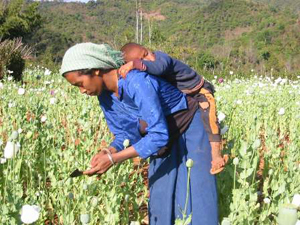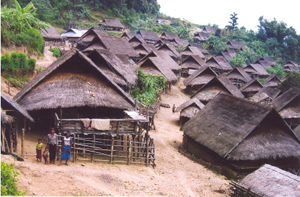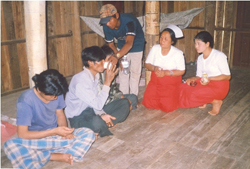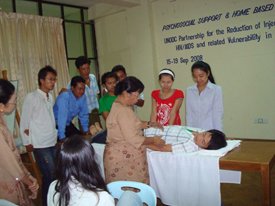
Myanmar was one of the first countries in the South East Asian Region to sign the UN Single Convention on Narcotic Drugs of 1961.
 In 1964, in response to an initiation from Myanmar's Government, a United Nations Preliminary Joint Survey Team visited the country to survey the economic and social needs of the opium producing regions. Soon afterwards, the Government of Myanmar enacted a prohibition of the sale of opium in Shan State, which became effective on October 1st, 1965.
In 1964, in response to an initiation from Myanmar's Government, a United Nations Preliminary Joint Survey Team visited the country to survey the economic and social needs of the opium producing regions. Soon afterwards, the Government of Myanmar enacted a prohibition of the sale of opium in Shan State, which became effective on October 1st, 1965.
In February 1974, the Government put into place a new Narcotics Law. This law imposed a ban on the cultivation of illicit narcotic crops, provided for the compulsory registration and treatment of drug addicts, and enacted heavy penalties for illicit cultivation, manufacture, possession, consumption and trafficking of narcotic drugs.
UNFDAC
In 1972, the Chairman of the International Narcotics Control Board (INCB) and the Special Representative of the Secretary-General in charge of the United Nations Fund for Drug Abuse Control (UNFDAC) visited Myanmar to develop a better understanding of how the United Nations could assist the Government's efforts to improve drug policy and reduce drug use in Myanmar.
 Four years later, in May 1976, Phase I of the UN/Burma Programme for Drug Abuse Control was signed. The $6.5m national programme worked to address Myanmar's drug problem through a variety of targeted programmes such as agriculture and livestock breeding as a means of income substitution, drug prevention in schools, public information campaigns, and the development of treatment and rehabilitation services for addicts.
Four years later, in May 1976, Phase I of the UN/Burma Programme for Drug Abuse Control was signed. The $6.5m national programme worked to address Myanmar's drug problem through a variety of targeted programmes such as agriculture and livestock breeding as a means of income substitution, drug prevention in schools, public information campaigns, and the development of treatment and rehabilitation services for addicts.
In February 1981 a multi-agency project formulation mission visited Myanmar to identify gaps that were present during Phase I of the programme. The mission processed to create Phase II of the UNFDAC/Burma Programme for Drug Abuse Control. This $ 5.4m Programme started in 1981 and continued until the launch of Phase III in 1986. The third phase of the Programme, launched on 12 June 1986, was the first to include new objectives relating to law enforcement.
Despite the implementation of these programmes, the political situation within Myanmar at the time limited the scale of UNFDAC's projects. The agreements reached with several ethnic insurgent groups in 1989, and with further groups in subsequent years, allowed the Government to begin social and economic development programmes in border areas Throughout the late 80's and early 90's.
As a result of a new strategy to reverse the existing trend in illicit drug production, trafficking and consumption, UNFDAC was replaced by the United Nations International Drug Control Programme (UNDCP), established in 1991 pursuant to General Assembly resolution 45/179 of 21 December 1990.
Memorandum of Understanding
The Ministry of Border Areas and National Races and Development Affairs (PBANRDA) was established in 1992 and developed a master plan for border area development involving all the main line ministries. Two strategies were implemented to address the country's drug problems: firstly, the declaration of the elimination of narcotic drugs as a national duty; secondly, the eradication of the practice of opium poppy cultivation, while, in parallel, improving the social and economic life of those living in border areas.
The Mekong Memorandum of Understanding (MOU) on Drug Control was signed by the Governments of China, Laos, Myanmar and Thailand and the UNDCP in 1993. All parties agreed to increase collaboration to ensure improved drug control measure in the region. Expansion of the MOU's membership, to include Cambodia and Vietnam, took place at a Ministerial Meeting held in Beijing in May 1995. The Meeting also approved a Sub-regional Action Plan prepared by UNDCP and the six Governments.
Drug Demand Reduction Projects
 Between 1993 and 1996, UNDCP implemented a demand reduction sub-project to improve preventive drug education activities along the border regions between Myanmar and China.
Between 1993 and 1996, UNDCP implemented a demand reduction sub-project to improve preventive drug education activities along the border regions between Myanmar and China.
In October 1995, in partnership with the Governments of Myanmar and Thailand, UNDCP started a project to reduce demand for narcotic drugs and for the very first time - prevention of HIV infection in specific border areas. The first injecting drug users related project started in March 1998 and ended in December 2000. New approaches like Participatory Learning Appraisal (PLA) and Stepping Stones - a gateway for ex-users and addicts to seek assistance - were innovative programs that represented the development of a more multidimensional drug policy in Myanmar.
As one of the 6 MOU countries, Myanmar participated to the Project for Reducing Illicit Drug use in the Highlands of East Asia. Through participatory community-based demand reduction and social development activities, this project aimed to reduce illicit drug use and related social problems in selected highland communities of East and Southeast Asia. Seven Project sites in the northern Shan and Kachin were selected in Myanmar. The project was initially scheduled to be implemented between September 1996 to December 1999, but was later extended until June 2000.
Alternative Development and Sustainable Livelihoods Projects
UNODC began its first alternative development programme in the Southern Wa Region during 1994-95. Subsequently two more projects were conducted in the Wa Special Region and Shan State. These projects included assistance to communities through the development of a clean water supply through projects such as the construction of water channels, and increased assistance to hospitals and schools.
In 1998, UNODC initiated a 10 year project, Drug Control and Development in the Wa Region of Shan State, with the aim of establishing a sustainable, community-based approach to the reduction and eventual elimination of the opium supply in Wa Region.
Additionally, Myanmar participates in the Global Partnership on Alternative Development Projects which promotes sustainable livelihoods in several countries, including Lao PDR, Bolivia, Colombia and Peru.
UNODC currently engages with Myanmar through Illicit Crop Monitoring Projects and its annual Southeast Asia Opium Survey. UNODC works throughout the year to research and develop a better understanding of, the extent of, and causes for, opium poppy cultivation in Myanmar. This data is published yearly, alongside information about other opium growing countries in the region, in the Opium Survey.
Drugs and HIV/AIDS Projects
 Through the experience gained and lessons learned from the sub-regional Highland Project, UNODC Country Office in Myanmar (COMYA) formulated a Community based DDR Project in three key townships in the northern Shan State. This is a comprehensive project, covering 30 villages, and involving activities such as advocacy, drug prevention education, community-based treatment and rehabilitation, drugs and HIV/AIDS awareness, gender, micro-credit for the women in the communities, and the empowerment of women. Simultaneously, UNODC, in conjunction with UNAIDS, trained Police Officers about drugs and HIV/AIDS-related legal issues. The Implementing Partner of the Project was
CARE Myanmar.
Through the experience gained and lessons learned from the sub-regional Highland Project, UNODC Country Office in Myanmar (COMYA) formulated a Community based DDR Project in three key townships in the northern Shan State. This is a comprehensive project, covering 30 villages, and involving activities such as advocacy, drug prevention education, community-based treatment and rehabilitation, drugs and HIV/AIDS awareness, gender, micro-credit for the women in the communities, and the empowerment of women. Simultaneously, UNODC, in conjunction with UNAIDS, trained Police Officers about drugs and HIV/AIDS-related legal issues. The Implementing Partner of the Project was
CARE Myanmar.
A European Commission funded project, Reducing Injecting Drug Use and its Harmful Consequences in Union of Myanmar, covered the same areas in northern Shan State and Kachin State during the first Phase, with INGO Partners such as CARE Myanmar and
Medicine du Monde. One of the highlights of the project was that UNODC was permitted to train prison staff, as well as inmates, about drugs and HIV/AIDS prevention in 30 prisons and camps.
Within the framework of the Fund for HIV/AIDS in Myanmar (FHAM), UNODC was responsible for the setting up of a Technical Coordination Unit, which works to coordinate all partners working in the field of HIV/AIDS. Although the Project completed its formal term in May 2007, the activities have continued. This project was implemented in partnership with Township Project Management Committees, INGOs, NGOs and Community Based Organizations to provide prevention activities, basic health care services and the distribution of infection containment materials to injecting drug users (IDUs), their partners, and families, via drop-in-centres and outreach activities. The activities of outreach projects are linked with referral services to drug treatment and methadone maintenance activities where possible.
Since January 2008, UNODC is engaged in the implementation of the project Reducing the spread of HIV/AIDS among injecting drug users through the HAARP Country Flexible Programme in Myanmar. The Project has a strong advocacy component, which is designed to influence the government to increase support for drug-related national programs.
